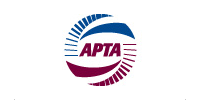
Nearly 5.3 billion trips were taken on U.S. public transportation in the first six months of 2015, according to a report released today by the American Public Transportation Association (APTA). This is a 0.9 percent decrease over the same period last year, representing 50 million fewer trips.
The following public transportation systems reported the highest ridership in their history: Capital District Transportation Authority (Albany, NY); Caltrain (San Carlos, CA), EMBARK (Oklahoma City, OK); Metro Transit (Minneapolis, MN); Piedmont Authority for Regional Transportation (Greensboro, NC), and Sound Transit (Seattle, WA).
Noting that the average price of gas during the first six months was $2.56, a drop of 29 percent, APTA President and CEO Michael Melaniphy said, “With a significant drop in gas prices, some people may have returned to driving, but still, most people continued their trips on public transportation. Considering the cost of owning and maintaining a car, public transit still offers a great way to save money.”
APTA’s most recent Transit Savings Report shows that an individual in a two-person household can save nearly $9,400 by living with one fewer car.
“Public transportation services offer individuals access to jobs,” said Melaniphy. “Since nearly 60 percent of trips are taken on public transportation for work commutes, public transit ridership often increases when employment goes up.”
The following are a few examples of local job growth and corresponding ridership increases that occurred from January-June of this year. In the large Seattle metro area, 49,000 jobs were added from January-June. Besides Sound Transit, which saw record ridership with a 6.7 percent increase, the Washington State Ferries saw a ridership increase of 4.5 percent and the King County Department of Transportation ridership increased by 0.9 percent. In the mid-size city of Austin, TX, public transit ridership increased by 5.6 percent when 18,000 metro area jobs were added during the first six months. Finally, in the Salinas, CA metro area, 4,688 jobs were added and unemployment decreased by 1.2 percent. Trips on the Monterey-Salinas Transit system increased by 9.2 percent.
2015 January - June Ridership Breakdown:
Nationally, heavy rail ridership increased by 0.5 percent in the first six months of 2015 with nine of 15 systems reporting increases. Cities with heavy rail systems showing the highest percentage of increases were located in the following cities: San Francisco, CA (4.3%); Atlanta, GA (3.1%); Philadelphia, PA (2.3%); Jersey City, NJ (2.1%); New York, NY-MTA Staten Island Railway (1.9%); Cleveland, OH (1.7%); and Miami, FL (1.3%).
Ridership on commuter rail systems increased by 0.3 percent in the first half of 2015 as 16 of 28 systems reported increases. Commuter rail in Orlando, FL saw a triple digit increase of 208.7 percent due to new service starting in May of 2014. Commuter rail in the following cities also saw double digit increases: Seattle, WA (14.5%) and Anchorage, AK (11.3%). Other commuter rail systems showing increases in ridership were located in the following cities: Austin, TX (9.8%); San Carlos, CA (7.3%); Nashville, TN (5.5%); Stockton, CA (4.5%); Oakland, CA (4.0%); Salt Lake City, UT (3.7%); Harrisburg-Philadelphia, PA-Penn DOT (3.1%); Newark, NJ (3.0%); Philadelphia, PA (1.5%); New York, NY-MTA Long Island Railroad (1.3%); Chesterton, IN (1.2%); and New York, NY-MTA Metro-North Railroad (1.2%).
Overall, light rail ridership decreased by 0.4 percent in the first six months of 2015 with 12 of 28 systems reporting increases. Light rail in Minneapolis, MN saw a triple digit increase of 113.6 percent due to a new light rail line opening in June 2014 which is still driving ridership. Light rail systems in the following cities saw double digit increases from January- June in 2015: Buffalo, NY (20.9%); New Orleans, LA (15.0%); Tampa, FL (13.1%); and Houston, TX (11.8%). Other light rail systems showing increases in ridership were located in the following cities: Oceanside, CA (6.3%); Seattle, WA (5.9%); and San Diego, CA (2.0%).
Bus ridership decreased nationally by 2.3 percent from January-June. However, in cities with populations of more than one million, bus ridership in the following cities showed increases: San Diego, CA (5.9%); Pittsburgh, PA (5.2%); Atlanta, GA (3.1%); Baltimore, MD (2.8%); San Jose, CA (1.7%); Seattle, WA (1.6%); Portland, OR (1.5%); and Philadelphia, PA (1.4%).
Demand response (paratransit) increased from January-June in 2015 by 1.2 percent. Trolleybus ridership decreased by 5.3 percent in the same period.
About APTA
The American Public Transportation Association (APTA) is a nonprofit international association of 1,500 public and private sector organizations, engaged in the areas of bus, paratransit, light rail, commuter rail, subways, waterborne services, and intercity and high-speed passenger rail. This includes: transit systems; planning, design, construction, and finance firms; product and service providers; academic institutions; transit associations and state departments of transportation. APTA is the only association in North America that represents all modes of public transportation. APTA members serve the public interest by providing safe, efficient and economical transit services and products. More than 90 percent of the people using public transportation in the United States and Canada ride APTA member systems.




Comments
There are no comments yet for this item
Join the discussion